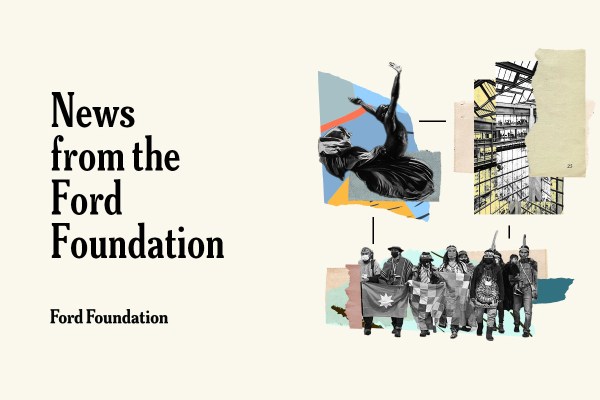
For the better part of two decades, the world of philanthropy has been engaged in an important, sometimes contested, conversation about “impact”—both how we measure it and how we deliver it. More recently, this discussion—in the Ford Foundation’s halls and throughout our sector—has focused on how to create impact through the capital market, specifically through impact investing.
As with most foundations, our own impact-related work—our support for individuals, institutions, and ideas—has remained almost entirely separate from the way we steward our endowment. While most of our work is grantmaking, the vast majority of our assets are actually financial investments.
Since 1969, US tax law has mandated that foundations pay out a minimum of 5 percent of their total assets each year. For the Ford Foundation, in recent years, meeting (and often exceeding) this requirement has translated to an annual grantmaking budget of around $500 million to $550 million. Meanwhile, we put the other 95 percent of our assets to work in the investment market, with the goal of earning financial returns that sustain the grantmaking power of our endowment over time. This, I hasten to add, is no easy task.
I believe the time is right for us to look at this paradigm with fresh eyes—to consider how we might start to bridge the gap between philanthropic impact and investments. Indeed, as I wrote last year in “Moving the Ford Foundation Forward,” we have come to believe that if we expect to overcome the forces of injustice and inequality, we need to expand our imaginations and our arsenals. In short, we must begin to more deliberately leverage the power of our endowment.
And so I am pleased that after many months of analysis and planning, the Ford Foundation’s Board of Trustees has authorized the allocation of up to $1 billion of our endowment, to be phased in over 10 years, for mission-related investments (MRIs). While this field is still emerging, we are making this commitment because we believe MRIs are the next great tool for social transformation, in philanthropy and beyond.
If philanthropy’s past half century was about optimizing the 5 percent, its next half century will be about beginning to harness the 95 percent as well, carefully and creatively.
Accessibility Statement
- All videos produced by the Ford Foundation since 2020 include captions and downloadable transcripts. For videos where visuals require additional understanding, we offer audio-described versions.
- We are continuing to make videos produced prior to 2020 accessible.
- Videos from third-party sources (those not produced by the Ford Foundation) may not have captions, accessible transcripts, or audio descriptions.
- To improve accessibility beyond our site, we’ve created a free video accessibility WordPress plug-in.
Our history in impact investing: Program-related investments (PRIs)
This decision was a long time coming, and would not be possible if not for the hard work of so many pioneers and visionaries in the impact investing community. Indeed, it represents the next step in a long march that stretches back to the very beginnings of impact investing.
Fifty years ago, in April 1967, Ford Foundation staff presented a report to trustees, titled Program-Directed Investments. It argued that philanthropy was about more than grantmaking.
Our predecessors believed that philanthropy “should be viewed as a continuum of contractual options with the outright grant placed at one extreme, something close to a market investment at the other, and in between a series of alternatives representing ascending degrees of gifting.” The following year, the foundation sought and received a ruling from the IRS that allowed us to create a new investment vehicle called program-related investments, or PRIs.
By law, PRIs are charitable investments. They take the form of loans, guarantees, and equity. These investments are directly aligned with a foundation’s programmatic commitments and must meet legal charitable standards, as well.
Like grants, PRIs generally come out of a foundation’s program budget and count toward the 5 percent foundations are required to pay out every year. Unlike grants, PRIs are expected to be repaid. They are not, however, expected to provide a return at competitive, risk-adjusted market rates. PRIs often allow for both higher levels of risk and lower levels of financial return than conventional financial investments.
We have found PRIs to be one of the most effective arrows in our quiver. Since 1968, the foundation has directed more than $670 million to PRIs, supporting social entrepreneurs and community development institutions around the world in their efforts to, among other things, preserve affordable housing, improve access to financial services and markets, create quality jobs, and advance arts and culture. And, as expected, our PRI fund has broken even—or better—over time, while making catalytic investments. PRIs allow us to take risks consistent with our mission in ways that much larger investors, such as banks and pension funds, often cannot or will not.
Our predecessors of 50 years ago understood that philanthropy is a spectrum with a host of options—options that have continued to grow and mature over the decades. While PRIs have allowed foundations like ours to tap the power of our grantmaking budgets in novel ways, today, our mission compels us to explore how we might mobilize our most significant financial resource: our endowments.
The next step: Mission-related investments (MRIs)
At its most basic level, philanthropy always has been about directing financial capital to solve social problems. And foundations always have had a unique relationship to our capitalist system, a relationship I explored two years ago in my essay “Toward a New Gospel of Wealth.”
I am often reminded of how Henry Ford II urged our forebears to “examine the question of our obligations to our economic systems.” He asked that we consider how philanthropy, “as one of the [market] system’s most prominent offspring, might act most wisely to strengthen and improve its progenitor.”
This obligation has become more pronounced in recent years. As a global foundation committed to fighting injustice, it is not lost on my colleagues and me that the very same systems that produce inequality also created our endowment, which, wisely invested, continues to fund our fight against inequality.
Since our mission has been funded by returns on our endowment, we have come to believe, firmly, that we have a special responsibility—and unique opportunity—to help influence the very markets that allow us to operate.
Clearly, one way we can do this is by taking a measured and carefully considered step to experiment with new kinds of investments that enlarge the meaning of the word returns.
This is not a new consideration. Concerns about socially responsible investing go back to the founding of modern stock markets centuries ago—and debates about reconciling the gains in “sin stocks” with ethical standards and religious values.
Since the 1980s, divestment movements around the world have asked institutional investors, in particular, to consider how their investments are related to the wider world. Whether they were demanding divestment from tobacco, fossil fuels, or apartheid South Africa, these movements reminded us that our investments are part of a broad ecosystem of consequences, intended and unintended—consequences that we realized we could not ignore.
Today, we have an opportunity to build on this proud, powerful legacy. Previous divestment movements tried to prevent investors from harming society; now, institutional investors can begin to move from “do no harm” to exploring how to “do more good.”
That brings us to mission-related investments, or MRIs. Through this new tool, we will leverage the power of our endowment, and start to unlock the potential of the 95 percent to create impact through the market. MRIs seek to achieve attractive financial returns while also advancing the foundation’s mission. Unlike PRIs, MRIs can bring to bear large amounts of capital in the service of multiple bottom lines.
Why now: The changing landscape
The Ford Foundation is not the first to commit a portion of its endowment to MRIs. We follow in the footsteps of—and are learning from—those foundations that pioneered the use of this tool. They include the early signatories to the More for Mission movement, as well as a number of other foundations that have announced new and significant initiatives in recent years, including the Rockefeller Brothers Fund, Kellogg Foundation, John D. and Catherine T. MacArthur Foundation, Kresge Foundation, McKnight Foundation, F.B. Heron Foundation, Wallace Global Fund, Surdna Foundation, Bill & Melinda Gates Foundation, and Open Society Foundations. While these institutions have taken a variety of approaches, their commitment demonstrates leadership and courage. Their initial steps should inspire all of us to consider how we might leverage the power of our endowments to promote dignity, equality, and justice for people around the world.
Significant changes in the capital markets have also made this step much easier for us to explore, and hopefully for others to consider, too. All manner of financial institutions, from private wealth advisers to large asset owners, are now deploying investment products to meet the rapid increase in investor demands for sustainable investments.
In the past, there have been three main reasons why most American foundations have not invested any portion of their endowments into MRIs.
First, legal uncertainty served as a barrier. Until recently, it was not clear whether MRIs could meet the prudent investor standards that government sets for how foundations can invest their endowments. But last year, the United States Treasury clarified its position, establishing the legality of MRIs as part of a larger effort to encourage them.
Second, there have been legitimate questions about whether there is enough evidence to prove that mission-related investments yield desirable financial or social returns.
We’ve come to realize that if we hope to answer this second question, it is our responsibility to put more of our money where our mouths are. For this promising sector to continue to grow and mature, it needs more data, which requires a greater depth of experience and a greater measure of leadership. While the Ford Foundation has previously been willing to commit grant dollars, we are now excited to take the next step and commit endowment dollars, too.
The experience of others has given us reason to be optimistic, as has the continued growth of the field. For example, over the past few years the tools available to measure social impact have become increasingly precise, thanks in large part to the work of several leading institutions:
- The Sustainability Accounting Standards Board (SASB), an independent council, has worked to standardize corporate reporting of material nonfinancial data in areas like employment, environmental sustainability, and governance.
- An initiative of the Global Impact Investing Network, IRIS (Impact Reporting and Investment Standards) is a catalog of accepted performance metrics that helps guide investors who want to consider their social and environmental impact.
- The Global Impact Investing Ratings System (GIIRS) rates companies and funds based on their environmental and social impact, in a manner similar to Standard & Poor’s credit risk ratings. GIIRS is hosted by B Lab.
- The Mission Investors Exchange is the leading network of foundations committed to collective learning and mobilizing their assets in ways that align with their mission.
Third and finally, when it comes to investment management, the boards of most foundations (ours included) are focused on maintaining the grantmaking power of endowments over time. Boards are the faithful stewards of our portfolios, with the duty to ensure that foundations make only rock solid, reliable investments. And rightly so: Hanging in the balance is the continuation of all the important work and organizations that foundations support.
Yet I believe that our posture can and should gradually evolve, that we can responsibly steward our assets while finding a path toward more transformational impact. While we recognize that MRI funds are newer—and therefore less tested and trusted—they nonetheless present a clear opportunity for exactly this type of evolution.
Our decision
And so, for our part, the Ford Foundation has decided to gradually and prudently invest up to $1 billion of our endowment in MRI funds, to be phased in over the next 10 years.
This decision is a natural extension of our history of PRI investing, which will continue to play an important role in our approach to impact. It is deeply rooted in our ongoing program work to build more inclusive economies, help mature the impact investing sector, and fulfill our special obligation to help move market-based economies toward “the high road”—squaring the dynamism of markets with society’s highest values, especially fairness and human dignity.
This work represents a new frontier for us, and will require new people with new skills. So, we will build a special team of dedicated, veteran investment professionals to manage our MRIs. Unlike our excellent, existing investment team, this group of financial analysts and advisers focused on MRIs will report to our program leadership, and be held accountable for social and financial returns that contribute to our mission and, over time, to our annual programmatic payout, as well.
As for the objective of our MRIs, our early efforts will target areas that have long been central to our mission of disrupting inequality in all its forms. In the United States, we’ll start by examining investments that make housing more affordable and inclusive. And in developing countries, we’ll look at how MRIs could expand access to vital financial services, particularly for low-income and other underserved communities.
Not only will what we invest in reflect our values—how we make these investments and report on them will be informed by our mission, as well. We hope to make diversity, equity, and inclusion bywords of this investment movement, paying attention to the makeup of investment teams, as well as where they invest and with what values. We join a growing number of committed pension funds, universities, foundations, and other institutional investors in not only considering diversity and inclusion but also recognizing how it can be a powerful contributor to performance and impact. And we will make our financial and impact performance completely transparent, to help move the wider marketplace forward.
In every way possible, we will work to ensure that these MRIs complement the work we are already doing through our grantmaking and PRIs, and contribute to our larger vision for a more equal, more just world. And to be clear: This careful, gradual allocation of some endowment resources to MRIs will have little to no impact on our grantmaking budget.
We believe we can achieve attractive financial returns while also contributing to meaningful social progress by following a steady, deliberative approach, building in strong oversight and risk management by our board of trustees, and working fully with partners in the private, public, and nonprofit sectors. Throughout this process, we will learn as we go and share as we learn.
The next great challenge for philanthropy
Of course, while I am profoundly pleased that the Ford trustees have made a significant commitment to MRIs, we know that a billion dollars—despite being a lot of money—is not nearly enough to grow and prove this space.
One of my former colleagues, Antony Bugg-Levine, a founder of the impact investing movement, has framed the problem presciently. He often says that our social challenges and social capital form a kind of ledger, with liabilities on one side and assets on another. The fact is, we face trillions of dollars in risks and liabilities—whether from environmental degradation, disease burden, lack of affordable housing, persistent joblessness, the impact of structural and systemic racism and gender bias, or so many other drivers and consequences of inequality—compared with only a few billion dollars of philanthropic assets. With the gap so wide and the stakes so high, we cannot afford to leave any option unexplored.
My conviction is that this moment offers us an opportunity to help capital markets become accelerators of justice. And my hope is that, before long, many more foundations, of all kinds and sizes, will find ways to tap the power of their own endowments to help contribute to multiple bottom lines. Pension funds, university endowments, sovereign wealth funds, and others can do the same, in ways consistent with their respective missions, expertise, and fiduciary obligations. In time, I fervently believe, we will see a thriving, mature sector in which everyone can make impact investments that produce both sustainable financial returns and substantial social returns. Maybe it will take decades more to get there. But we’ll never know if we don’t make a start.
Since the birth of foundations, our endowments have been essential to our work. Going forward, I believe they will become an essential part of our work and how we continue that work into the future. This is the next great challenge in philanthropy: to find and finance more social good than we ever have before.
It is a challenge we will rise to meet together.
If you have questions about our MRI investments, please contact [email protected].
Avoiding scams: Individuals using the foundation’s name without authorization have contacted people by social media, text messages and email to suggest that mission-related investments are available if they pay a fee. These messages are fraudulent. Please note that the foundation never charges a fee in connection with any of its grant related activities.

